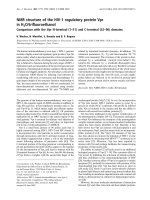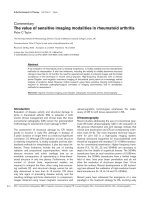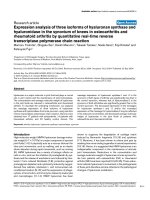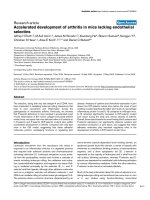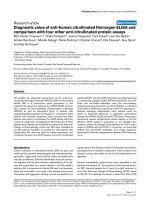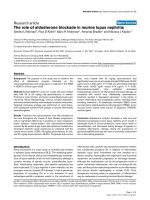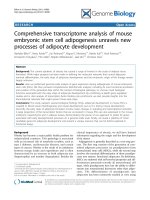Báo cáo y học: " Comprehensive comparison of three commercial human whole-exome capture platforms" pdf
Bạn đang xem bản rút gọn của tài liệu. Xem và tải ngay bản đầy đủ của tài liệu tại đây (226.3 KB, 46 trang )
This Provisional PDF corresponds to the article as it appeared upon acceptance. Copyedited and
fully formatted PDF and full text (HTML) versions will be made available soon.
Comprehensive comparison of three commercial human whole-exome capture
platforms
Genome Biology 2011, 12:R95 doi:10.1186/gb-2011-12-9-r95
[no first name] Asan ()
Yu Xu ()
Hui Jiang ()
Chris Tyler-Smith ()
Yali Xue ()
Tao Jiang ()
Jiawei Wang ()
Mingzhi Wu ()
Xiao Liu ()
Geng Tian ()
Jun Wang ()
Jian Wang ()
Huangming Yang ()
Xiuqing Zhang ()
ISSN 1465-6906
Article type Research
Submission date 23 May 2011
Acceptance date 28 September 2011
Publication date 28 September 2011
Article URL />This peer-reviewed article was published immediately upon acceptance. It can be downloaded,
printed and distributed freely for any purposes (see copyright notice below).
Articles in Genome Biology are listed in PubMed and archived at PubMed Central.
For information about publishing your research in Genome Biology go to
/>Genome Biology
© 2011 Asan et al. ; licensee BioMed Central Ltd.
This is an open access article distributed under the terms of the Creative Commons Attribution License ( />which permits unrestricted use, distribution, and reproduction in any medium, provided the original work is properly cited.
Comprehensive comparison of three commercial human whole-exome capture
platforms
Asan
2,3,
*, Yu Xu
1,
*, Hui Jiang
1,
*, Chris Tyler-Smith
4,
*, Yali Xue
4
, Tao Jiang
1
, Jiawei
Wang
1
, Mingzhi Wu
1
, Xiao Liu
1
, Geng Tian
1
, Jun Wang
1
, Jian Wang
1
, Huangming
Yang
1,#
and Xiuqing Zhang
1,#
.
1
Beijing Genomics Institute at Shenzhen, 11F, Bei Shan Industrial Zone,
Yantian District, Shenzhen 518083, China
2
Beijing Institute of Genomics, Chinese Academy of Sciences, No.7 Beitucheng West
Road, Chaoyang District, Beijing 100029, China
3
Graduate University of Chinese Academy Sciences, 19A Yuquanlu, Beijing 100049,
China
4
The Wellcome Trust Sanger Institute, Wellcome Trust Genome Campus, Hinxton,
Cambridge CB10 1SA, UK
#
Corresponding authors: Huangming Yang (),
Xiuqing Zhang ()
*equal contributors
Abstract
Background
Exome sequencing, which allows the global analyses of protein coding sequences in
the human genome, has become an effective and affordable approach to detecting
causative genetic mutations in diseases. Currently, there are several commercial
human exome capture platforms; however, the relative performances of these have not
been characterized sufficiently to know which is best for a particular study.
Results
We comprehensively compared three platforms: NimbleGen's Sequence Capture
Array and SeqCap EZ, and Agilent's SureSelect. We assessed their performance in a
variety of ways, including number of genes covered and capture efficacy. Differences
that may impact on the choice of platform were that Agilent Sureselect covered
approximately 1,100 more genes, while NimbleGen provided better flanking
sequencing capture. Although all three platforms achieved similar capture specificity
of targeted regions, the NimbleGen platforms showed better uniformity of coverage
and greater genotype sensitivity at 30-100 folds sequencing depth. All three platforms
showed similar power in exome SNP calling, including medically-relevant SNPs.
Compared with genotyping and whole-genome sequencing data, the three platforms
achieved a similar accuracy of genotype assignment and SNP detection. Importantly,
all three platforms showed similar levels of reproducibility, GC bias and reference
allele bias.
Conclusions
We demonstrated key differences between the three platforms, particularly advantages
of solutions over array capture and the importance of a large gene target set.
Background
Identifying the genetic alterations underlying both rare and common diseases, and
also other phenotypic variation, is of particular biological and medical relevance.
Even after a decade’s effort by the genetics research community since the completion
of the first human genome sequences [1-2], the majority of genetic mutations
underlying human diseases remain undiscovered. For example, the causative
mutations for more than half of human rare diseases [3], the genetic architecture of
most common diseases [4-5] and the roles of somatic mutations in most cancers
[6],have yet to be characterized. Whole genome re-sequencing can potentially
identify these uncharacterized mutations, and in the past few years great strides have
been made with massively parallel DNA sequencing (MPS) technologies that can be
applied to the whole genome [7-10]. However, the cost of these technologies remains
too high for them to be used in as a standard method. Recent integration of targeted
exome capture with MPS to selectively re-sequence the best-understood functional
parts of human genome – the <2% protein-coding sequences – provides an effective
and affordable alternative to identify some of these causative genetic changes.
Several platforms for human exome capture for MPS have been developed and
marketed to date [11-14]. In principle, these platforms fall into three classes: DNA-
chip-based capture [11-12], DNA-probe-based solution hybridization [14], and RNA-
probe-based solution hybridization [13]. These platforms have enabled great success
in pioneering studies hunting for variants causing rare human diseases [11, 15-21],
and have also been adopted in efforts towards deciphering human common diseases
and cancer genomes. Yet questions remain about how to choose among these
platforms: how many human genes are targeted by each approach and how even is
their coverage? How do capture efficacy, technological reproducibility and biases
among the different platforms compare? How much input DNA is required and how
convenient is each experimentally? And how does the cost-effectiveness compare?
What is the power and accuracy of SNP calling, especially for medically-important
rare SNPs? Up till now, publicly-accessible methodology explorations have been
limited to proof-of-concept studies [11, 13-14, 22], reviews [23-24], or comparisons
carried out on only a subset of genes rather than at the whole-genome level [25].
To provide the community with a more solid means to determine the best platform for
their experimental needs, we have performed a comprehensive comparison of three
commercialized human exome capture platforms: NimbleGen's Sequence Capture
Array (Human Exome 2.1M Array, Roche-NimbleGen), NimbleGen's SeqCap EZ
(v1.0, Roche-NimbleGen), and Agilent’s SureSelect (Human All Exon Kits, Agilent).
Each of the three platforms represents one of the classes of exome capture technology
currently available. To assess performance with regard to key parameters including
reproducibility, we conducted deep exome capture sequencing for each platform with
two technical duplicates (>30x and >60x coverage) using DNA derived from a cell
line from a previously-sequenced Asian individual [26]. Other key performance
parameters characterized here included the genes targeted, the efficacy of exome
capture (including specificity, uniformity and sensitivity), technological biases, and
the power and accuracy of exome capture data for subsequent SNP calling. Our
findings provide comprehensive insights into the performance of these platforms that
will be informative for scientists who use them in searching for human disease genes.
Results
Human exome capture with three platforms
We chose platforms that allowed a comparison of the three different methods
currently in use for exome capture. The platforms are based on a chip-hybrid method
(NimbleGen Sequence Capture Array) or a solution-hybridization method
(NimbleGen SeqCap EZ) with a common set of DNA probes, and a solution
hybridization method with RNA probes (Agilent SureSelect). The test DNA sample
was from a cell line derived from the individual used in the YanHuang whole-genome
sequencing analysis [26], allowing comparison with the existing high-coverage
genome sequence.
We sought to comprehensively compare the performance of the three exome-capture
platforms using the best protocols and experimental design for each. We therefore
optimized the standard library construction protocols for all three platforms (see
Materials and Methods): we minimized the input DNA to 10 ug, 3 ug, and 3 ug for
Sequence Capture Array, SeqCap EZ and SureSelect, respectively, and set pre-capture
PCR to 4 cycles and post-capture PCR to 10 cycles for all three platforms. We
included duplicates for each technique to ensure the reliability and assess the
reproducibility of data production. We thus constructed a total of six libraries for the
three platforms and the used the HiSeq2000 to initially produce >30-fold coverage of
unique mapped paired-end 90-bp reads (PE90) for each library. We further sequenced
one of the two replicates for each platform to >60-fold coverage to obtain a combined
coverage of ~100 fold for the purpose of discovering the impact of sequence depth on
genotype calling for each of the platforms.
Targeted genes and coverage
One intrinsic feature of exome capture is its capacity for simultaneous interrogation of
multiple targets depending directly on the genes targeted by the capture probes. We
first compared the targeted genes and their coverage among the three platforms. As
the two platforms (array and EZ) developed by NimbleGen shared a common set of
targets, we only needed to compare the Agilent and one NimbleGen platform. We
annotated protein-coding genes using a merged dataset of 21,326 genes from the
CCDS (release of 2009.03.27), refGen (release of 2009.04.21) and EnsemblGen
databases (release 54), and micro RNA genes using 719 genes from the human
microRNA database (version 13.0). We also included the 200-bp most-flanking
regions from both ends of the targeted sequences: typically, 200-bp flanking regions
are co-captured with capture libraries constructed from 200–250 bp fragments.
The two target sets were 34.1Mb (NimbleGen) and 37.6Mb (Agilent) in size, and
shared 30Mb of targets in common, leaving 4.1Mb specific to NimbleGen and 7.6Mb
specific to Agilent (Table S1 in additional file 1). Correspondingly, although both
target sets contain similar percentages of functional elements (exomic, >71%;
intronic, >24%; and others, <5%), Agilent covered ~1,000 more protein-coding genes
and ~100 more microRNA genes (17,199 protein coding genes, 80.6% of the database
total; 658 microRNA genes, 91.4%) than NimbleGen (16,188 protein-coding genes,
75.9%; 550 microRNA genes, 76.5%) (Table S2 in additional file 1). Of those protein-
coding genes, 15,883 overlapped between NimbleGen and Agilent, while 305 were
unique to NimbleGen and 1,316 unique to Agilent. Further analyses showed no over-
representation of any class of annotated disease genes in the NimbleGen- or Agilent-
specific genes (Table S3 in additional file 1). In addition, both included roughly 1.6
transcripts per gene, a value consistent with the average number of transcripts per
gene in the RefSeq database. The results indicated that the majority of known human
genes and their splice alternatives were well accounted for in both capture probe
designs.
We assessed the coverage of the protein-coding sequences (CDs) by the two
platforms, and again, Agilent-targeted regions showed much better coverage (72.0%
of targeted genes with >95% CDs, and 78.5% with >90% CDs) than NimbleGen’s
(46.1% of targeted genes with >95% CDs, and 61.5% with >90% CDs) (Figure S1 in
additional file 2). However, when including the flanking regions, the coverage was
much more improved for NimbleGen (74.2% targeted genes with >95% CDs and
76.0% with >90% CDs) than for Agilent (82.0% targeted genes with >95% CDs and
83.0% with >90% CDs) (Figure S1 in additional file 2). This reduced the gap in CDs
coverage rate (from >17% to <8%) between the two analysis sets and indicated a
more important role of flanking region capture for NimbleGen.
To obtain more detailed information about the target coverage of these two systems,
we looked specifically at their ability to interrogate human disease genes using four
known data sets (see below). Of the 5,231 unique genes collected from OMIM
(release of 2011.03.10), HGMD (Professional 2009.2), GWAS (release of 2011.03.03)
and CGP databases (release of 2010.12.01), Agilent targeted 4,871 with 86% of genes
having >95% of CDs covered, in comparison with NimbleGen’s 4,642 genes with
83% of genes and >95% of CDs covered (Figure S2 in additional file 2). Thus, for the
current pool of disease-genes, both could interrogate most known genes, especially
those linked to rare diseases, for which 85% of known causative mutations occur in
CDs. This makes both capture methods especially attractive for rare disease-gene
identification and analysis.
Exome capture specificity
To assess the extent of exome enrichment, we compared capture specificity of the
three platforms, which was defined as the proportion of reads mapping to target
regions. For the two replicates of each platform, we obtained a total of 26–80 million
filtered reads (2.2–7.2 Gb, Table 1), roughly corresponding to >30- and >60-fold
coverage of the targeted regions. We mapped these reads to the human genome (hg18)
using the strategy described in the Materials and Methods. Although the overall
proportion of filtered reads that could be mapped (78.8%-86.4%) or uniquely mapped
(69.2%-82.8%) to the human genome differed between the six replicates, the
proportions of reads mapped uniquely to targeted regions were more comparable
(54.2%-58.1%) among the three platforms (Table 1). We also found the percentages of
uniquely mapping reads were further improved (by up to 12%) for the two
NimbleGen platforms by the inclusion of 200 bp flanking regions in the analyses (for
the Agilent platform, this was only 2%). Thus, the final percentage of usable reads
was 66.6% for two NimbleGen platforms but was <60 % for Agilent. These results
indicated that there is a general comparability of capture specificity for targeted
regions among the three platforms if the mapping method did not include the flanking
region sequences. However, under mapping procedures where researchers do include
this information, the NimbleGen platforms perform better.
Uniformity of coverage
The uniformity of sequence depth over targeted regions determines the genotype
sensitivity at any given sequence depth in exome capture. The more uniform the
sequencing depth on the targeted region is for a platform, the lower the depth of
sequencing that is required to obtain a desired genotype sensitivity. To assess this
important quality metric, we selected and analyzed a similar number of reads (~25
million filtered reads, on average ~30-fold coverage) from each of the six replicates
(Table 2). We found that, although all three platforms showed high coverage of their
own targeted regions at low sequencing depth (98%-99% with >1x), the Agilent
platform showed more bias towards very low and very high coverage (21% with
<10x, 20% with >50x) than the two NimbleGen platforms (<15% with <10x, 7% with
>50x). As a result, the two NimbleGen platforms had 10%-15% more targeted regions
(70%-74%) within 10x-50x coverage than the Agilent platform (59%). This
observation was further supported when we looked at the normalized single base
sequencing depth distribution (Figure 1); the curve of the two NimbleGen platforms
showed less skew to low and high coverage depths, and more evenness around the
mean coverage (~30x), than that of the Agilent platform; that is, the NimbleGen Array
showed the best evenness. In addition, the two NimbleGen platforms also showed
better uniformity of coverage in flanking regions (Table 2), which is consistent with
their better efficiency of capture seen when including the flanking region sequences
(Figure S3 in additional file 2). Thus, the two NimbleGen platforms had a better
overall uniformity of sequencing depth than Agilent, which would be expected to
impact the relative genotype sensitivity when considering all targets.
Genotype sensitivity
Although the coverage of >99% of each targeted region of >1-fold using all data sets
an upper boundary for exome capture sensitivity for each replicate, only a proportion
of these sites gained high-quality genotype assignments. To characterize this issue, we
compared the genotype sensitivity in the 30x data sets (Figure 2A) using the criterion
of >10-fold coverage and phred-like quality >30. In these analyses, all three platforms
showed very high genotype sensitivity (>77%); but, in comparison, the two
NimbleGen platforms showed 6%-8% higher (>83%) genotype sensitivity than the
Agilent platform (~77%), which is consistent with their better uniformity in coverage-
depth.
To obtain a more comprehensive insight, we further analyzed genotype sensitivity at
other sequencing depths (Figure 2B) by randomly sampling from the combined
sequencing data of the two replicates for each platform. Overall, the genotype
sensitivity improved for all three platforms in a similar way as sequencing depth
increased, and reached as high as >92% at ~100-fold coverage. The genotype
sensitivity of the two NimbleGen platforms was often higher than the Agilent
platform at a given sequencing depth. For example, genotype sensitivity was between
72%-91% for the NimbleGen platforms at the usual sequencing depth of 20-50 folds,
while it was 64%-85% for Agilent. Of interest, the curves of the two NimbleGen
platforms nearly overlapped when sequence coverage depth was >30-fold. This
indicates that these two platforms, which shared a common set of DNA capture
probes, have good inter-comparability.
We also analyzed genotype sensitivity at flanking regions; better NimbleGen results
further emphasized the importance of the flanking regions for NimbleGen. Taken all
above together, we conclude that all three platforms had high genotyping calling
sensitivity at >30-fold coverage (>77%), with NimbleGen platforms showing slightly
better performance.
Reproducibility
Technical reproducibility reflects the consistency of performance of each exome
capture platform. Using the replicates for each of the three exome-capture platforms,
we determined the level of reproducibility within each platform. In considering inter-
platform comparability as well, our evaluation focused on the set of targets that were
shared between the all three platforms (totaling 182,259 CCDS covering 25,392,537
bp). This, respectively, accounted for 70.1% and 66.1% of sensitivity in the
NimbleGen and Agilent targeted regions. Using the ~30x data set, we analyzed the
correlation of both coverage rate and mean depth on the CCDS between any two of
the six replicates (Figure 3). Each platform showed high intra-platform reproducibility
(correlation coefficient at >0.65 for coverage rate and >0.90 for depth). The lower
correlation coefficient for coverage rate (0.65-0.78) than for mean depth (0.90-0.96)
was not surprising since the two correlations reflect different aspects of the data, i.e.
the quantitative sequencing depth and qualitative sequence coverage. For the inter-
platform comparison, the two NimbleGen platforms showed higher correlation than
either with Agilent. This is consistent with the fact that the two platforms share a
common set of DNA capture probes. These results together indicate generally high
and comparable technical reproducibility of the three methods.
GC bias and reference allele bias
Base composition has been shown to have a systematic effect on capture performance
[13]. To explore this effect, we plotted the mean sequencing depth against the GC
content. All three platforms showed biases against extremely low GC content (<20%)
and high GC content (>75%), and the best coverage for GC content of 40-60 %
(Figure S4 in additional file 2). However, we also observed a better coverage for the
NimbleGen array platform, which had a better coverage of low GC content sequences
without reduced coverage of the best-covered GC content. Thus, extreme GC content
still poses a challenge for exome capture, but the chip-hybridization method
(NimbleGen array platform) would likely be a better choice for targeted capture of
genomic regions with lower GC content.
The allelic status of the probe sequences could also influence allelic capture efficiency
at heterozygous sites, especially in situations where there are a large number of novel
alleles being interrogated by exome capture. This occurs because the probes match the
reference sequence and might capture perfectly-matching library fragments better. To
explore the impact of allelic status on the different platforms, we compared the ratio
of reference allele depth to total depth for heterozygous sites in each exome capture
with that in YanHuang whole-genome shotgun sequencing (WGSS). All three
platforms showed consistent and significant biases towards the reference allele in
capture (Figure S5 in Additional file 2), whereas WGSS did not have this bias. These
results emphasize the need to account for the effect of reference allele bias in exome
sequencing of tumors, in which acquired somatic mutations at any frequency may
occur.
Non-covered sequences
Even at 100-fold sequencing depth, a small proportion of the target region was still
not covered by each platform. To gain insight into this issue, we analyzed the base
composition of these missed sequences. In total, there were 97,654-190,318 bp
sequences (0.29%-0.56% of two targeted regions) not covered at all by the combined
full sets of data for each platform. Of these sequences, 19,803 bp sequences (10%-
20% of the non-covered sequences) overlapped in all three platforms, and 71,257
(33% and 70% of the non-covered sequences) overlapped between the two
NimbleGen platforms. The GC content was >72% for Agilent, >80% for NimbleGen
Array, >79% for NimbleGen EZ, and 76% for all shared sequences. Thus, at very high
sequencing depth (~100x), the non-covered sequences for all three platform were
biased towards extremely high GC content.
SNP detection
Given that exome capture is used primarily to identify genetic variants, we compared
the SNP-detection power among the three platforms. To do so, we called SNPs in the
targeted regions together with 200 bp flanking sequence at high quality genotype-
assigned sites in each of the ~30x data sets, and annotated them using the combined
gene set used in the target annotation. Each platform detected roughly 25,000-40,000
SNPs, of which the largest group were from intronic regions, followed by
synonymous SNPs and then non-synonymous SNPs, and finally by other categories
(Table S4 in additional file 1). The over-representation of intronic SNPs was more
marked for the two NimbleGen platforms, where it provided over 10,000 more SNPs
(35,000-40,000 in all) than Agilent (25,000). Given the use of the same DNA and the
similar proportion of intronic regions between NimbleGen and Agilent, this seems to
be largely associated with the increased efficiency of capture by the NimbleGen
platforms, especially in the flanking sequences. However, for synonymous and non-
synonymous SNPs, which together represent the most functionally important groups,
the Agilent and NimbleGen data showed substantial overlap and nearly similar levels
of SNPs per gene to whole genome re-sequencing of the same individual. Thus, the
three platforms could interrogate a similar high level of SNPs within protein-coding
sequences in their targeted genes, which harbor changes that are most likely to have a
functional impact.
Accuracy of genotype and SNP calling
To assess their accuracy, we compared the genotypes and SNPs from each replicate
(30x data) of the three platforms with those of Illumina 1M beadchip genotyping and
WGSS (about 36x) from the YanHuang project [26]. For better data comparability, we
also derived genotypes for the WGSS using the same software and criteria as for the
exome capture (see Materials and Methods).
In comparison with the Illumina 1M beadchip genotyping, which includes 1,040,000
successfully typed sites, each replicate showed ~39,000 to ~51,000 overlapping sites
depending on the platform, and showed an overall genotype concordance of >99.81%
for these sites (Table 3). In addition, each platform also achieved a similar high
concordance rate with those variant sites found in chip genotyping, with >99.51% for
all the SNP sites, and >99.56% for non-reference homozygous sites, and of particular
note, even >99.48% for heterozygous sites, the genotypes of which are more difficult
to assign than homozygous sites (Table 3). Relatively, the concordance of chip
genotyping to the variant sites in each exome capture was also high, with >99.81% for
all the SNP sites, and >99.88% for non-reference homozygous sites, and >99.71% for
heterozygous sites (Table 3). These comparisons give a maximum estimate of both
false negative and false positive of the three exome captures of <0.52%.
In contrast, the two NimbleGen and Agilent datasets overlapped at 48,000,000 sites
(with 83.8% sensitivity in targets) and 34,500,000 sites (with 76.2% sensitivity in
targets) with WGSS genotypes, respectively. The substantially higher overlap of
NimbleGen was attributed to its greater intronic content. This time, each exome
capture platform showed a concordance of >99.999% for all overlapping sites, but
>99.20% for all SNP sites, >99.92% for the homozygous non-reference sites and
>97.90% for the heterozygous sites found in WGSS (Table 3). In comparison, the
relative concordance of WGSS to the variant sites called in each exome capture was
>97.97% for all SNP sites, >99.75% for the homozygous non-reference sites, and in
particular was reduced to >96.65% for the heterozygous sites (Table 3), which is still
acceptable. Note that for the heterozygous sites, compared to NimbleGen, Agilent
showed ~1% reduction in concordance. In these analyses, cell-line DNA (~40
generations) derived from lymphoblasts was sequenced using a read-length of 90 bp,
while in WGSS reads of 36 bp in length were generated from whole blood DNA.
Thus, cell-line mutations, and errors due to increased sequencing length (errors
accumulate with sequencing length) in the study may account for part of the decrease
in concordance. Based on these results, the general false positive and false negative
rate of each exome capture platform for SNP detection was <3.4 % and <1.0%,
respectively.
Taken together, these results indicated that although slight differences could be
observed, accuracy was both high and comparable among the three platforms.
Detection of medically-interesting rare mutations
To further explore the power for identifying disease-causing rare mutations, we
modeled the performance of the three exome capture platforms with the SNP set
present in HGMD (Professional 2009.2) but absent from the 1000 Genomes Project
data (BGI in house data) (Table 4). Of the 39,906 mutations representing 1,931
diseases genes, both Agilent and NimbleGen targeted >95.8% sites, and showed
>93.4% sites with at least 1x coverage and genotype sensitivity of >79% sites (>10x
coverage and >Q30) at 30x sequencing depth. But in comparison, Agilent targeted
more sites (98.5% compared to 95.8%), and correspondingly showed ~1.5% more
covered sites (>1x coverage) (95.1% compared 93.4%) than NimbleGen. In contrast,
NimbleGen (with the best performance of NimbleGen Array Capture) showed 1.4%
more genotype sensitivity (80.4% compared to 79%), and 3.6% less low quality
coverage sites or uncovered sites (15.2% compared to 18.8%), than Agilent. The
number of known potentially disease-causing SNPs detected ranged from 14 to 19
(Table 3). These observations were consistent with the larger targeted-gene set of
Agilent, and the higher capture efficiency of NimbleGen. Thus, the analyses
demonstrated the very high power of the three exome capture platform for identifying
medically-interesting rare mutations.
Performance on common targeted regions
Hitherto, most of the comparisons were based directly on the current versions of the
three platforms, which may not reflect only the intrinsic differences in performance
among the three methods, but also the differences in content. To address this issue, we
compared key performance parameters on the ~30Mb of targeted regions in common
(83.3Mb with flanking sequences) (Table S1 in additional file 1). For specificity, we
found that each replicate of the three platforms showed a somewhat reduced unique
mapping rate of >44% filtered reads to the common targeted regions, and that two
NimbleGen platforms achieved on average a 12% higher unique mapping rate than
Agilent when including the 200-bp flanking sequences in the analyses (Table S5
Additional file 1). This result is consistent with the initial analyses above. For
uniformity and sensitivity, we also found that each platform showed very similar
performance to that above, and that the two NimbleGen platforms performed better
than the Agilent one (Table S5 in additional file 1). For example, at a sequencing
depth of 30x, NimbleGen had on average ~6% higher genotype sensitivity than
Agilent (85% compared to 79%). For SNP detection, the detection level of each SNP
category in each platform, including the greater detection of intronic SNPs (and thus
the total SNP number) by the NimbleGen platforms (>13,000 more SNPs than
Agilent, >35,000 compared to ~22,000), was also similar to the analyses above (Table
S4 in additional file 1); but in comparison, despite general inter-comparability, the two
NimbleGen platforms detected ~400 more coding-SNPs (12,400 compared to 12,000)
in the common targeted regions while Agilent detected ~900 more coding-SNPs
elsewhere (13,500 compared to 12,600) (Table S4 in Additional file 1). This
difference could be explained by the fact that NimbleGen had a better capture
efficiency while Agilent targeted a ~4Mb larger region and correspondingly 1,000
more genes. Finally, for the accuracy of SNP detection and genotypes, we also
observed a similar false positive and false negative rate for each platform at 30x
coverage (Table S6 in additional file 1) to that in whole dataset, in comparison with
the data from array genotyping and WGSS. Thus, we conclude that each platform was
highly consistent in performance in the common targeted region analyses here
compared with the analyses of the entire content above, which is not surprising given
the high overlap (Agilent, 30Mb/34.1Mb ≈80%; NimbleGen, 30Mb/40Mb ≈88%) .
Discussion
In this study, we present a comprehensive comparison of three widely-adopted human
whole-exome capture platforms from two manufacturers. Since the three platforms, in
principle, represent the three classes of exome capture technologies currently
available, data on their performances likely also reflect the intrinsic power and
limitations of exome capture as a technology.
For the current versions of the three platforms, the number of targeted genes and their
CDs coverage rate are one important consideration for human genetic studies.
Although most well-annotated human genes (>76%) were targeted by all three
platforms, Agilent sought to target a larger set of genes (~1,000 more protein-coding
genes and ~100 more microRNA genes) and thus provided a better coverage of
protein-coding sequences. In contrast, NimbleGen emphasized a more important role
for flanking regions in capture probe design, and, in practice, had a greater number of
genes with a high rate of CDs coverage (Figure S6 in additional file 2) due to better
capture efficiency.
Exome capture efficiency is another important factor for comparison of capture
platforms. In our hands, we observed that the two NimbleGen platforms showed
better capture efficiency than Agilent. Specifically, the two NimbleGen platforms
showed ~10% higher capture specificity with the expanded targeted regions (66.6%
compared to 58.3%), better uniformity of coverage, and 7%-3% more sensitivity in
genotype assignment (83%-95% compared to 76%-92% over the range 30x-100x
coverage of targeted regions). Thus, a lower sequencing depth was required for
NimbleGen platforms for a given genotype sensitivity on targeted regions, which can
impact experimental cost.
The ability to identify SNPs in protein-coding sequences, especially those medically-
interesting rare mutations, which ultimately measures the power of exome
sequencing, was another important consideration. Despite general inter-comparability
(12,500-13,500 SNPs), we found that, at the same sequencing depth (30x),
NimbleGen detected a more complete set of SNPs (~400 more SNPs) than Agilent for
the common targeted coding sequences due to better exome capture efficiency, but
Agilent could detect more SNPs (~900 SNPs) in total number due to its larger number
of targeted genes. Similarly, for identifying medically-interesting rare mutations, we
found in model analyses that all three platforms not only showed similar high power
at 30x sequencing depth in interrogating known HGMD mutations filtered to remove
1000 Genomes Project variants present in the general population, but the small
differences reflected the general features of each platform (Agilent could target 1.8%
more, and cover 1.5% more mutation sites, but NimbleGen showed 1.4% more
mutations with high quality genotype assignment).
Input DNA amount, the convenience of conducting experiments and cost of reagents
will also be important considerations. Especially, the amount of DNA required for
each method itself will also impact cost as well as the ease of carrying out
experiments, and is a major consideration for precious biological samples with limited
availability. In these senses, the two solution hybrid platforms, Agilent and
NimbleGen EZ, showed great advantages over the chip hybridization platform. These
two solution-based platforms require smaller amounts of input DNA (~3ug) and no
specialized equipment. In addition, reagent costs for these two platforms are lower
with sample size greater >10, and could possibly be further reduced with the
introduction of sample pooling prior to the capture possess.
For performance aspects, such as the accuracy of SNP detection, GC bias and
reference allele bias, and reproducibility, we did not observe great differences among
the three platforms.
Taken together, our results here demonstrate that, although the three platforms showed
general comparability of performance, the two solution hybrid platforms would be the
leading choice for most studies, especially those using large numbers of samples. In
comparing these two, Agilent showed a larger set of targets, targeting a more
comprehensive set of human protein-coding genes and providing more complete
coverage of their CDs, while NimbleGen had a better capture efficiency and could
provide a higher proportion of CDs with high quality genotype assignments (thus
higher completeness of SNP detection), and required lower sequence coverage
because of its greater evenness. Thus, a choice between the two platforms is
surprisingly difficult: both are highly effective and the number of targeted genes, their
CDs coverage, the genotype sensitivity and the sequencing amount/cost required must
be balanced. The larger number of genes targeted by Agilent provides an overall
advantage in the versions used here, but it is important to point out that both
NimbleGen and Agilent are making great progress in target design. For example, in
the latest (July 2011) versions, both target sets have been expanded (NimbleGen
EZv.20 to 44Mb, Agilent to 50Mb), and currently cover more than >90% of annotated
human genes (Table S7 in additional file 1).
Conclusions
In conclusion, we demonstrate here a systematic evaluation of the performance of the
current versions of three human whole-exome capture platforms. The data reported
here will make it easier for researchers to more carefully assess the type of exome-
capture technology that will work best for their experimental goals and costs, and
allow them to improve their own experimental design to take advantage or reduce the
limitations of the available platform types.

